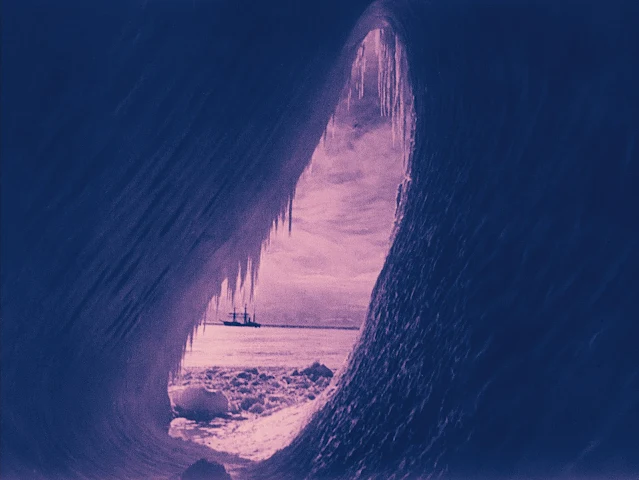
Cast: Robert Falcon Scott, Herbert G. Ponting, Henry R. Bowers, Edgar Evans, Lawrence E.G. Oates, Edward Adrian Wilson.
Back in the 1980s, Ted Turner provoked an outcry with his proposal to colorize the black-and-white films in his library. Filmmakers, historians, and critics protested, and with good reason: I remember watching Turner's colorized Casablanca (Michael Curtiz, 1942) and being startled by the paisley print on a blouse worn by Ingrid Bergman; I had never noticed it before the added colors made it stand out, which was certainly not the intention of the director, cinematographer Arthur Edeson, or perhaps even the costume designer, Orry-Kelly. Eventually, legislation put restrictions on such manipulation of old movies. But colorization was not a new thing: From the very beginning, filmmakers tried to add color to movies, usually by tinting the film stock a solid color: blue for night scenes; reds, oranges, and yellows for hot settings like Death Valley in Erich von Stroheim's Greed (1924); even pink for love scenes. Most silent movies after 1920 were colored in this way. But there were also attempts at more realistic coloring: For some of his short films, like A Trip to the Moon (1920), George Méliès used a technique devised by Elisabeth Thuillier, a kind of factory assembly-line of colorists who painstakingly added colors to the actors, costumes, and sets in each frame of the film. The technique proved too cumbersome and expensive as movies reached feature length. But it's one of the hallmarks of Herbert G. Ponting's documentary about the fateful Antarctic expedition of Robert Falcon Scott in 1910-13, The Great White Silence. Even though the whiteness of ice and snow is Antarctica's dominant feature, Ponting decided to hand-tint the footage he had shot ten years earlier, and thereby accentuated the contrast between human and animal life and the deadly whiteness of the continent. Color provides the life in the life-and-death struggle to reach -- and return from -- the South Pole. The images Ponting captured as the photographer for the expedition, using photographic equipment that now seems primitive, are the essence of the movie, and they often seem as fresh as if they were shot yesterday. Ponting was not allowed to accompany Scott from the base camp to the pole, which is from our point of view fortunate, as we might not have the record he made of the expedition now. But he filmed Scott and his fellow explorers as they rehearsed for the journey, trekking through the snows, setting up tents, bedding down, so he was able to give us at least some sense of what the men endured. Too bad that The Great White Silence is accompanied by a narrative that seems antique in ways that Ponting's images aren't. There's a lot of rather jingoist rhetoric about how Scott's expedition is a tribute to the English spirit, a credit to what Ponting calls "the Race," by which he seems to mean Anglo-Saxons. (One of the crew members has a pet black cat with an unfortunately racist name.) Ponting seems unconcerned with the irony that the doughty Englishmen of Scott's team failed to reach the South Pole before their chief competitor in the race, the Norwegian Roald Amundsen. Ponting's images of the animal life of Antarctica, seals and gulls and penguins, are accompanied by coy, condescending, anthropomorphic commentary that sets the tone for nature documentaries that followed. Still, it's an astonishing and invaluable film that fully merited the careful reconstruction that makes it available to us a century later.